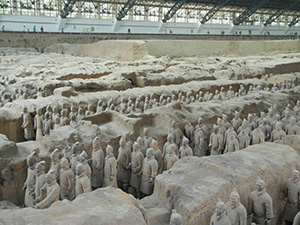|
The Remarkably Well-Crafted Terra-Cotta Army Reveals Secrets of China's Past
by Robin Mwai, age 15

In 1974, outside the city of Xi’an, China, a group of well diggers came across one of the most remarkable archaeological discoveries of all time: a life-size clay soldier. Chinese authorities were later notified and dispatched to the site, where they uncovered thousands of these clay soldiers.
Interestingly, each of the soldiers had unique facial expressions and were positioned in the tomb according to rank. One of my editors, Annie Shao, recently went to China and was able to see the tera-cotta army in person. After walking around the entire pit, she explained, “No two soldiers are alike, and each are life sized and incredibly detailed.” Small paint remnants hint that soldiers, now almost entirely gray, were once adorned with brightly colored clothes. Various weapons were also found intact. This terra-cotta army was created to accompany the first Chinese emperor, Ying Zheng, into his afterlife.
In 246 B.C., Zheng began his reign at age 13. Within 25 years, he had acquired many warring kingdoms and was renamed Qin Shi Di – the first emperor of Qin. Qin had a great impact on Chinese life during his rule. He standardized coins, weights, and measures; joined states with canals and roads; and built the first version of the Great Wall.
Partial excavations of three out of four different pits have successfully uncovered terra-cotta soldiers, horse-drawn chariots and many weapons. Archaeologists note that the fourth pit was found empty. This was a sign of the original unfinished construction. There are approximately 8,000 figures in the pits, but the exact count remains unknown.
Writings suggest even greater treasures yet to be discovered. Qin’s own tomb still remains unexcavated. A translation of court historian Siam Qin’s writings read, “The tomb was filled with models of palaces, pavilions and offices as well as fine vessels, precious stones and rarities.”
According to this account, the tomb may contain replicas of China’s landforms made from mercury, bronze and pearls. Experimental pits, dug around Qin’s tomb, reveal dancers, musicians and acrobats in contrast to the military poses of the well-known terra-cotta soldiers. Further excavations of this tomb are currently on hold, despite these findings.
The terra-cotta army is one of the world’s greatest archaeological findings. Even more expeditions are yet to come and are expected to turn up even more discoveries.
[Source:
National Geographic
]
|

